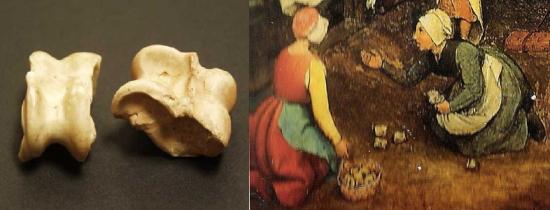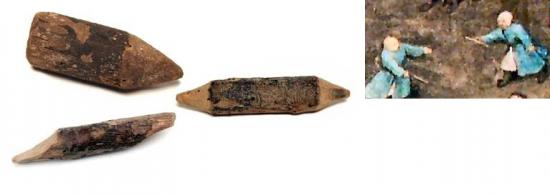PART.2
THE KNUCKLEBONES
Bones from the ankles of hoofed animals such as sheep, were used as playthings in the popular game Knucklebones. Six in total found at Harborough (four small and two large). The game was played usually with five knucklebones, which are thrown up and caught in various ways. Pieter Brueghel the Elder’s painting, Children’s Games represents the game in action.

A detail from ‘Children’s Games’ showing kucklebones being played (1560 AD) and the kucklebones from Harborough Market church (© Leicestershire County Council)
THE TIPCATS
Numbering 117 in total in the hoard, tipcats were clearly popular. They relate to a game played using two sticks, one large and one small: the smaller is the “cat,” often pointed at one or both ends, is hit into the air using the larger, before being hit a second time with the larger stick to drive it forward. All of the tipcat sticks found at Harborough are “cats”.

The tipcats from Harborough Market church (© Leicestershire County Council) and a detail from Brughel’s painting showing children playing with tipcats
SAP WHISTLES
Thirteen sap whistles were found. These were made from short lengths of young wood, alder or fruitwoods, which had the pithy core removed to form a tube, which was then blocked at one end. The whistle was then played by blowing across the top of the open end. Some tube wood items found were open at both ends, and it was suggested that these could have been used as pea shooters.

A sap whistle from Harborough Market church (© Leicestershire County Council)
CHILDREN IN ARCHAEOLOGY
Children in archaeology are often the invisible population, considered as variables in an adults world. Through their material culture – in the form of the artefacts found in this hoard – children can be understood in archaeological research as children in the present, “not just as individuals who will one day be adults”[ii] While the lives of children in late medieval times are often represented as brutal, and filled with experiences that would horrify the modern observer[iii], the discovery of this hoard reveals a more light-hearted and fun-filled character to childhood in the late sixteenth and early seventeenth centuries.
by Adrienne Corless
A graduate of NUIG Adrienne Corless is freelance archaeologist and former manager of the National Museum of Ireland’s Dublin Excavation’s Project
[i] The Harborough Hoard
[ii] Baxter, J. E., 2005, The Archaeology of Childhood; Children, Gender and Material Culture, AltaMira Press.
[iii] What was it like to be a child in Tudor times ?